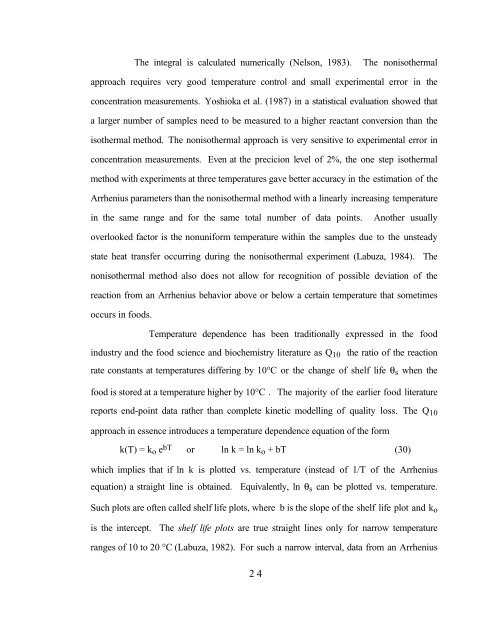the handbook of food engineering practice crc press chapter 10 ...
the handbook of food engineering practice crc press chapter 10 ...
the handbook of food engineering practice crc press chapter 10 ...
Create successful ePaper yourself
Turn your PDF publications into a flip-book with our unique Google optimized e-Paper software.
The integral is calculated numerically (Nelson, 1983). The noniso<strong>the</strong>rmal<br />
approach requires very good temperature control and small experimental error in <strong>the</strong><br />
concentration measurements. Yoshioka et al. (1987) in a statistical evaluation showed that<br />
a larger number <strong>of</strong> samples need to be measured to a higher reactant conversion than <strong>the</strong><br />
iso<strong>the</strong>rmal method. The noniso<strong>the</strong>rmal approach is very sensitive to experimental error in<br />
concentration measurements. Even at <strong>the</strong> precicion level <strong>of</strong> 2%, <strong>the</strong> one step iso<strong>the</strong>rmal<br />
method with experiments at three temperatures gave better accuracy in <strong>the</strong> estimation <strong>of</strong> <strong>the</strong><br />
Arrhenius parameters than <strong>the</strong> noniso<strong>the</strong>rmal method with a linearly increasing temperature<br />
in <strong>the</strong> same range and for <strong>the</strong> same total number <strong>of</strong> data points. Ano<strong>the</strong>r usually<br />
overlooked factor is <strong>the</strong> nonuniform temperature within <strong>the</strong> samples due to <strong>the</strong> unsteady<br />
state heat transfer occurring during <strong>the</strong> noniso<strong>the</strong>rmal experiment (Labuza, 1984). The<br />
noniso<strong>the</strong>rmal method also does not allow for recognition <strong>of</strong> possible deviation <strong>of</strong> <strong>the</strong><br />
reaction from an Arrhenius behavior above or below a certain temperature that sometimes<br />
occurs in <strong>food</strong>s.<br />
Temperature dependence has been traditionally ex<strong>press</strong>ed in <strong>the</strong> <strong>food</strong><br />
industry and <strong>the</strong> <strong>food</strong> science and biochemistry literature as Q <strong>10</strong> <strong>the</strong> ratio <strong>of</strong> <strong>the</strong> reaction<br />
rate constants at temperatures differing by <strong>10</strong>°C or <strong>the</strong> change <strong>of</strong> shelf life θ s when <strong>the</strong><br />
<strong>food</strong> is stored at a temperature higher by <strong>10</strong>°C . The majority <strong>of</strong> <strong>the</strong> earlier <strong>food</strong> literature<br />
reports end-point data ra<strong>the</strong>r than complete kinetic modelling <strong>of</strong> quality loss. The Q <strong>10</strong><br />
approach in essence introduces a temperature dependence equation <strong>of</strong> <strong>the</strong> form<br />
k(T) = k o e bT or ln k = ln k o + bT (30)<br />
which implies that if ln k is plotted vs. temperature (instead <strong>of</strong> 1/T <strong>of</strong> <strong>the</strong> Arrhenius<br />
equation) a straight line is obtained. Equivalently, ln θ s can be plotted vs. temperature.<br />
Such plots are <strong>of</strong>ten called shelf life plots, where b is <strong>the</strong> slope <strong>of</strong> <strong>the</strong> shelf life plot and k o<br />
is <strong>the</strong> intercept. The shelf life plots are true straight lines only for narrow temperature<br />
ranges <strong>of</strong> <strong>10</strong> to 20 °C (Labuza, 1982). For such a narrow interval, data from an Arrhenius<br />
24














